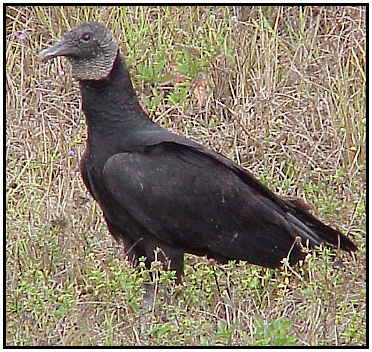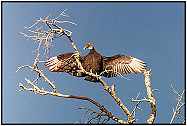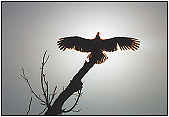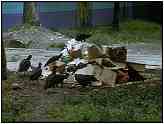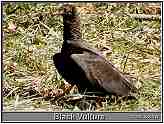American BlackOrder: Falconiformes. Family: Cathartidae. (New World vulture). Scientific Name: Coragyps atratus Common Names: Black Vulture, American Black Vulture, or Carrion Crow. (Sometimes incorrectly called the Black Buzzard. 'Buzzards' are more properly broad-winged hawks).
Black Vulture Photograph Courtesy of R.D. Scheer Copyright ©2000)Conservation Status: Common. In the Western hemisphere ome of the most numerous birds of prey, but the American Black Vulture is on the decrease, especially in Europe. Rescue & Recovery: As the scavenging habits of vultures provide such a benefit in removing sources of infection these birds are protected by law in most of the United States. Geographical Range: Found from the southern United States to central Patagonia. (North and South America). Habitat: Warm, open lands with some thinly wooded areas. Not found in deserts or on higher mountains. Physical Characteristics: This 55-68 centimetre long bird is almost completely black, right down to the bare wrinkly skin on its face. It is not until the Black Vulture takes to the air that white markings can be seen near the tips of its 1.5 metre wings. Maximum weight for this bird is about 1.9 kilograms with a length of about 56 centimetres, making the Black Vulture slightly smaller than the Turkey Vulture. To make up for this they are more aggressive than their cousins and quite capable of driving Turkey Vultures from a carcass. Like most vultures this bird is essentially silent, though when annoyed it may snarl or hiss, but without any great volume. In the wild these birds live for an average of five years.
Black Vulture Photograph Courtesy of Stephen Hendricks Copyright ©2000)Food: Most of the diet is carrion, though Black Vultures also feed on eggs and the fruit of the oil palm. This bird has discovered that road kill is an easy source of food and they can be found regularly patrolling main roads. They often become victims of the same cars which provide them with such easy meals. When the opportunity presents itself they will sometimes kill small ground creatures or domestic animals. Even vulture species which do kill prey practice this only rarely and vultures have weak feet with shortish toes as against strong talons suitable for hunting. Has taken to following the sent-seeking Turkey Vulture as a source of a food supply. When it comes to attacking a carcass the Black Vulture depends upon other species of vulture to tear open the tough hide. It has a thin weak beak and so cannot do this for itself. Black Vultures will fight savagely between themselves for food. When particularly pressed for a meal this species will eat ripe or rotten fruit. Reproduction: Colonies usually nest on the ground with the birds under overhanging rocks, or in stumps and holes. Will sometimes choose buildings. 1-3 eggs are laid (two being most common) at intervals of two days. Both parents incubate the eggs and jointly care for the young until they leave the nest at about ten weeks of age. Down covers the heads of the young and this is lost when the adult plumage grows in.
Black Vultures (Photograph Courtesy of Photohome.com Copyright ©2000)Other: Perhaps one of the most mysterious bird stories surrounds the Black Vultures of Gettysburg. For over 100 years more than 900 Black and Turkey Vultures have gathered amongst the canyons of the Gettysburg National Military Park in Pennsylvania. It is said that the first birds appeared on the 1st July, 1863. This was the final day in a battle which saw 50,000 men and thousands of horses die. The men were buried, but the corpses of the horses were left lying on the battlefield. The vultures dined in style, they may even have stayed the winter and scavenged on the frozen carcasses. Twelve months later the vultures returned, something they do to this very day..... Thumbnails (Click For Full-Size Image):
|

